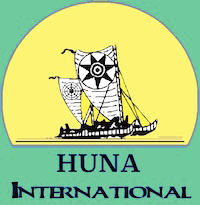Huna Article
Huna International
Lomi Styles
by Susan Pa'iniu Floyd
Two questions that are coming to me often these days, probably in response to two very good books written on
Lomilomi, are "Did the Hawaiians have many styles of lomilomi (Hawaiian massage)?" and "Is the 'temple'
style traditional?" I will answer these questions from what I was taught.
Yes, there are many different styles of Hawaiian massage. I have experienced quite a few and been told about
others. And there are probably many more styles I don't know about. Hawaiians valued massage as a favorite
way of relieving daily tensions. To them, it was a natural occurrence to undergo stress and it was equally
natural to relieve it. So, each day they would work on themselves, each other and if someone showed a real
talent, they would seek that person out for more difficult situations. The techniques were passed down from
generation to generation, especially from grandparent to grandchild. Each island, sometimes each side of
each island, even each valley, would develop it's own style. And each style would be authentic.
In Hula, there is a saying "All knowledge is not taught in one school." Some take this to mean that one must
study a little here a little there until all is learned. I learned another interpretation from Hula master
Uncle George Na'ope. He taught that learning in any halau (school) was very intense and took great
dedication. Therefore, students would be wise to keep their focus on their own learnings and not judge other
schools, even if what was taught was very different.
Historical research tells us that Hawaiians had schools to teach healing arts, Halau Ho'ola. A typical
period of time attending these schools was 20 years. Abraham Kawai'i, my lomilomi teacher, told us his
training was for 20 years. He was taught to master his mind, body and emotions and then to apply himself to
the art of Lomilomi. His "style" of application was performed only in the heiau (temples), only by masters,
and only on a select few. It was a total commitment to be present and responsive for an unknown period of
time, as long as it took to release all tensions. So, a lot of his training had to do with commitment and
trust.
Is this "temple" style a traditional form of lomilomi? I wasn't alive then, I can only say what I was
taught. All the writers of all the books about lomi today weren't alive in ancient times. We are all sharing
what we have been told. We are all a part of the whole. There is an idea from Huna that helps me: Mana - all
power comes from within. We each have the power, right and responsibility to choose what we believe. Does
believing that a particular style of lomilomi is ancient make for deeper experiences, deeper learnings? Does
being part of a lineage help? If yes, then great, if not, then decide it's all made up. In any event, choose
beliefs that support desired results, beliefs that will open up doors to further adventures. There are so
many discoveries still to make for us all!
Copyright Aloha International 2006

|

